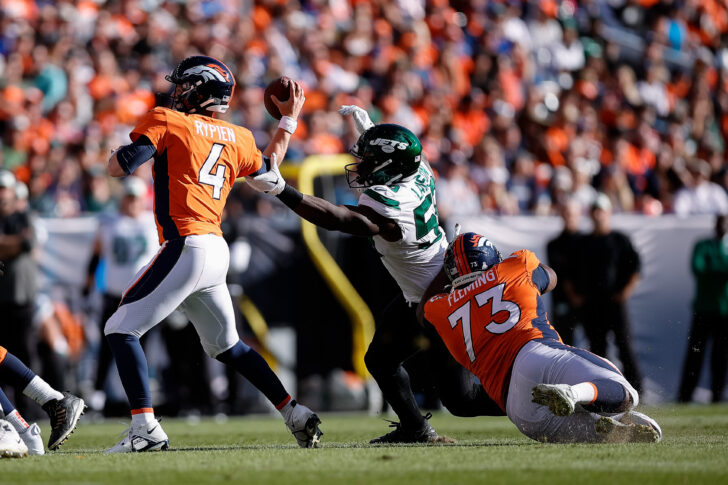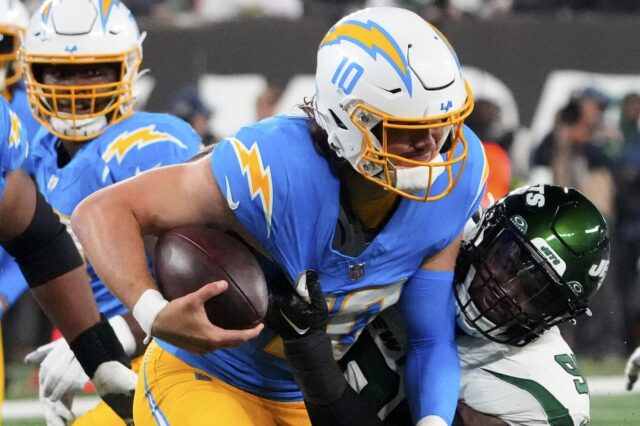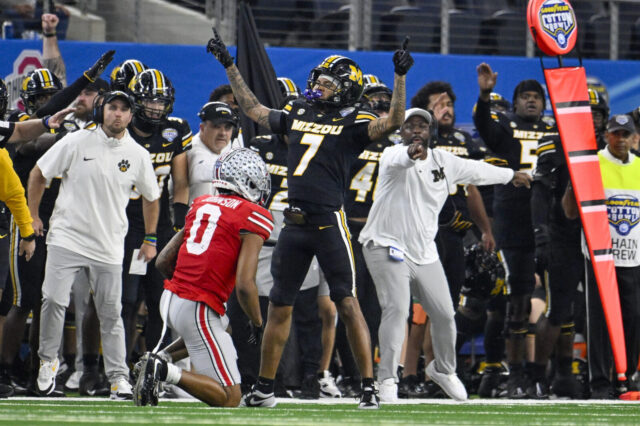The Denver Broncos’ offensive line was one of the biggest problems on a problem-filled offense in 2022, and fixing that line will be one of the first orders of business in 2023, but that’s easier said than done.
What elements of the line have to be fixed, and how can the Broncos accomplish that feat? Let’s take a look at the performances from this past season for answers.
Quinn Meinerz & Garett Bolles
It’s easy to see how Quinn Meinerz and Garett Bolles are the only players in the first tier, as it seems like they’re the only starters on the offensive line with a greater than 50% chance to return, but even still, you could argue Meinerz deserves a tier of his own.
Meinerz was the Broncos’ best offensive lineman this season by a comfortable margin, despite not taking the seismic leap that his physical gifts and past developmental track record suggest is possible. It’s hard to not blame Butch Barry and the abhorrent offensive coaching staff as major reasons, but the fact Meinerz opened the season off of injury, and then had to deal with a constant rotation of surrounding pieces also handicapped him.
Nonetheless, he performed as an above-average starting NFL guard from a pass-protection standpoint, and was a true road-grader in the run game. Among the 51 guards with at least 425 pass-blocking snaps, he finished the season ranked 23rd in Pro Football Focus’ pass-blocking efficency metric, while allowing the eighth-fewest pressures. In the run game, among the 57 guards with at least 250 run-blocking snaps, he graded out as PFF’s fifth-best run-blocking guard overall, and the second-best run-blocking guard on gap scheme runs.
With proper coaching and just a little bit of help from the quarterback and his fellow linemen, and the sky is the limit for Meinerz.
Quinn Meinerz is just living his best life 😂 pic.twitter.com/7eqythglao
— Bryce 🎸 (@MileHighMims) January 9, 2023
Meanwhile, Garett Bolles currently exists as one of the greatest lingering enigmas on the Denver Broncos’ roster.
He’s been the the team’s best offensive lineman for a few seasons now, but without Mike Munchak around, he showed some clear signs of regressions. His holding issues, which had faded during his rise to dominance, were back at full force to open the 2022 season. His ability as a blocker also showed signs of regression.
From 2017 to 2019, Bolles was penalized an average of 0.96 times per game. In 2020 and 2021, Bolles’ emergent seasons, the left tackle was penalized an average of 0.52, an improvement of 45.8%. In 2022, he backslid all the way down to 1.20 penalties per game. Now, some of that is the smaller sample size, as Bolles played just five games, but it’s a dramatic decline nonetheless, so there’s probably something to it, even if one thinks that something was the coaching staff and nothing more.
It’s also cemented by the pressures numbers, as Bolles allowed 2.31 pressures per game during his first three years in the league, 1.21 pressure per game over 2020 and 2021, and then 2.00 this past season.
Bolles has a $17.8 million cap figure next season, and the Broncos would stand to free up $9.8 million by moving on from him. Restructuring might be the most appealing option to Denver, but Bolles might not be interested in that, which would force George Paton to choose between over-paying for a depreciating asset — though, he’s familiar with that *cough* Russell Wilson *cough* — and opening up yet another hole on a leaky offensive line that’s trying to win games right now.
Graham Glasgow & Dalton Risner
This tier is perfect for capturing the Denver Broncos’ predicament of wanting to upgrade their offensive line, while also not wanting to upgrade additional holes.
Graham Glasgow is set to have a $14 million cap hit next season, which is outrageous considering what Glasgow provides the Broncos on a down-to-down basis. By cutting him, they can free up a tasty $11 million. However, Glasgow was sneaky good at center last year, producing the 20th-best pass-blocking efficiency score among the 33 qualifying centers, and finished the season sixth in the NFL (among centers) in ESPN’s run-block win rate metric.
As a result, the Broncos will likely look to cut Glasgow and sign him back on a cheaper deal, but then you risk exposing him to the open market.
Garett Bolles said he hopes Dalton Risner is back next year, but that’s out of his control.
— Zac Stevens (@ZacStevensDNVR) January 9, 2023
Dalton Risner, on the other hand is set to be a free agent, and might even earn a starting-level deal elsewhere. If that happens, it would force the Broncos to spend some of their assets on finding a new starting level guard. However, Risner has struggled to the point to which maybe that’s a desirable outcome, but that path does come with a cost.
Ultimately, the lack of communication between the two sides suggests it’s likely the Colorado-born offensive lineman is elsewhere in 2023.
Cameron Fleming, Billy Turner & Calvin Anderson
Of all these tiers, this is by far the messiest, as the rotating brigade of tackles each had their high points and each had their low points.
Cameron Fleming was surprisingly the most impressive of the bunch, as he settled into the starting right tackle spot for much of the season, and performed well there, particularly in the ground game. He allowed the fewest pressures per game of any of Denver’s tackles, including Bolles, and was penalized 0.40 times per game. Considering the holes the Denver Broncos might open up at tackle this offseason, bringing back Fleming could be an attractive option. He’s currently making just a little over $1 million, and at age 30, should have plenty more left in the tank. He also demonstrated swing ability this season.
Billy Turner, on the other hand, was surprisingly the most disappointing of the bunch. He was unable to play in more than half of the Denver Broncos’ games, and when he did play, he was a sieve, allowing 19 pressures in just eight starts.
Anderson also allowed 22 pressures in his eight starts, and, like Turner and Fleming, is set to hit free agency this offseason.
It’s hard to imagine the Broncos managing this mass exodus at tackle while also upgrading the offensive line, but that’s the challenge George Paton will be tasked with this summer.
Luke Wattenberg & Quinn Bailey
Here we have a pair of experiments that experienced different levels of success.
Luke Wattenberg was a surprise draft pick, who snuck into the sixth round thanks to his high-end physical tools.
#9 IOL #RAS 2022
Luke Wattenberg is a OC prospect in the 2022 draft class. He scored a 9.59 RAS out of a possible 10.00. This ranked 23 out of 532 OC from 1987 to 2022. https://t.co/vqzNnFEla3 #RAS pic.twitter.com/wcwduyBki2
— Kent Lee Platte (@MathBomb) April 13, 2022
Now, in his rookie year, Wattenberg struggled in limited playing time. His pass-block efficiency score of 91.7 would be the worst among NFL starters by a wide margin, and he showed limited strength in the run game, but he also flashed a lot of the high-end movement skills that made him an NFL draft pick.
Also, Wattenberg was expected to be a project and definitely wasn’t expected to see the field this season. It’s ok that he struggled. Now, he shouldn’t be penciled into a 2023 roster spot, but he’s an experiment worth continuing if the next staff likes what they see.
The Quinn Bailey experiment went much worse, though that wasn’t Bailey’s fault. It was the fault of the staff, who decided to put Bailey at guard, despite him demonstrating his ability as an NFL tackle multiple times, and immediately being unplayable, even during the preseason, as a guard.
As a result, it’s hard to know what his future holds, but hopefully the Denver Broncos bring him back. He could provide some stability at tackle, which they could quickly find themselves desperate for.
Lloyd Cushenberry III & Tom Compton
This tier is the simplest to dissect of all those we’ve discussed so far today.
Lloyd Cushenberry III was a very promising draft prospect, but the Denver Broncos are now three years into the experiment and the results have been dreadful. He’s consistently been one of the worst centers in the league, and the positive effect his absence had on the offense was blatant.
If the Broncos were to bring back Cushenberry as anything other than a backup, it’d be a very dark omen for the state of the offensive line.
Meanwhile, Tom Compton was sidelined for much of the season with a back issue, and when he finally got onto the field, he played 30 snaps, allowed three sacks, and quickly exited with an injury. It feels like this might be the end of the road for Compton’s NFL career, so don’t expect him back.



